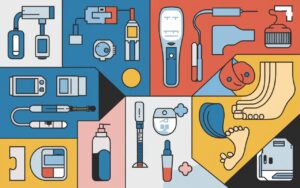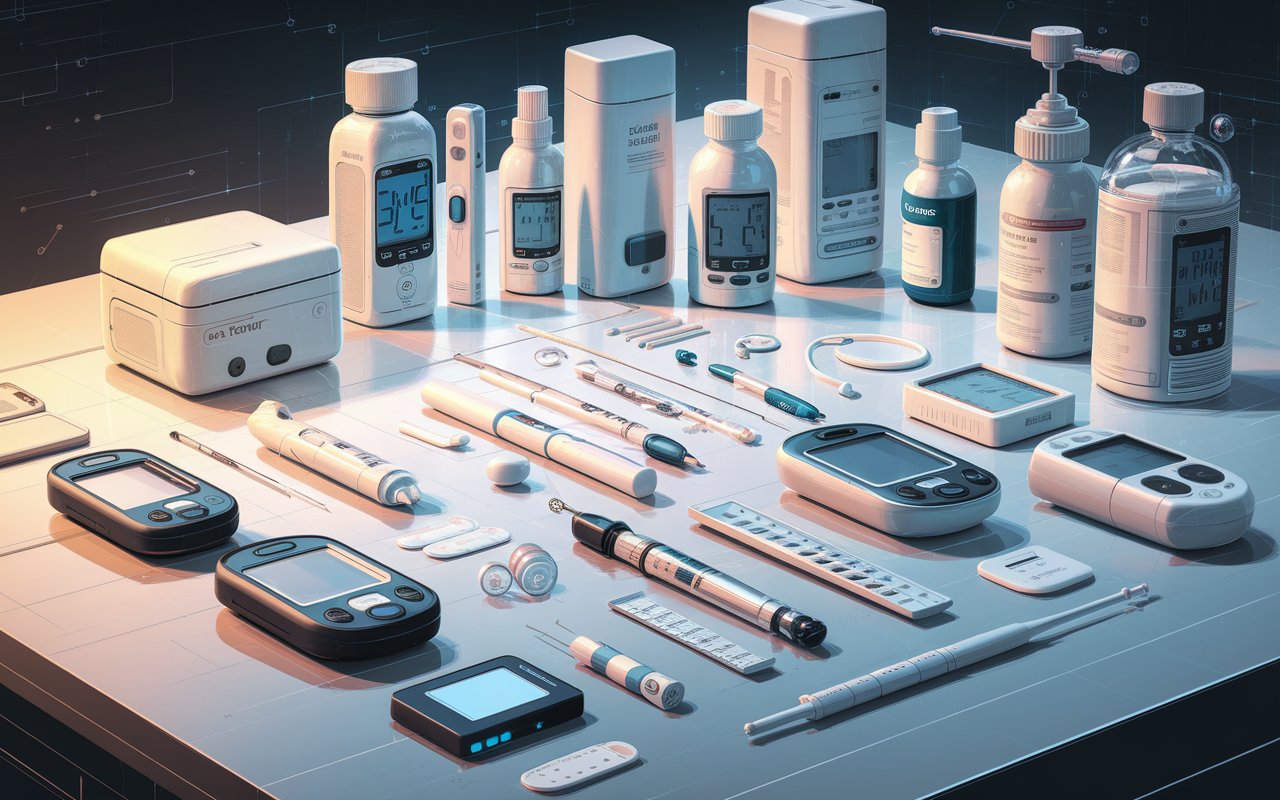Last Updated on September 16, 2024 by Alexander Sennuga
Are you struggling to keep up with your diabetes supplies?
You’re not alone!
Managing diabetes can feel like a full-time job, especially when it comes to staying stocked on essential items. But don’t worry—that’s exactly what this post is here to help with!
Get ready to dive into practical tips and insider secrets that will not only simplify your supply routine but also ensure you never run out when it matters most.
From selecting the right products to understanding insurance hacks, we’ve got the insights you need.
So grab a cup of coffee, sit back, and let us guide you through the maze of diabetes supplies, making your health journey a bit smoother and stress-free.
Types of Diabetes Supplies

Managing diabetes requires a comprehensive set of diabetes supplies to maintain healthy blood sugar levels and prevent complications. Here’s an in-depth look at the essential types of diabetes supplies you’ll need:
- Glucose Meters and Test Strips:
Glucose meters are the cornerstone of diabetes management. They provide quick and accurate blood glucose readings, allowing you to make informed decisions about your diet, exercise, and medication. Test strips are used with the meter to measure the glucose level in a drop of blood. It’s vital to choose a reliable glucose meter that suits your lifestyle, considering factors like result speed, memory capacity, and compatibility with digital health tools. - Continuous Glucose Monitors (CGMs):
CGMs offer a more sophisticated method of monitoring glucose levels. These devices consist of a small sensor placed under the skin, which continuously reads glucose levels in the interstitial fluid. CGMs provide real-time data and trends without the need for frequent finger pricks, making them ideal for those who want to keep a closer watch on their glucose fluctuations, especially during sleep or exercise. - Insulin Pumps and Pens:
Insulin pumps are devices that deliver continuous insulin to mimic the pancreas’s natural release of insulin. They’re ideal for people requiring intensive insulin therapy. Pumps allow for adjustable basal rates and boluses, offering precise control over insulin delivery. Alternatively, insulin pens provide a convenient way to administer insulin manually, featuring pre-measured doses and easy portability, suitable for on-the-go management. - Lancets and Lancet Devices:
Lancets are small, disposable needles used to obtain a blood sample for testing. A lancet device, or lancing device, is used to hold and control the lancet for a quick, virtually painless sample collection. Choosing the right lancet and device can greatly influence comfort and ease of use, with options available for varying needle sizes and depth settings. - Ketone Meters and Strips:
Monitoring ketone levels is critical for preventing diabetic ketoacidosis, especially in people with type 1 diabetes. Ketone meters measure ketones in blood samples, providing a more accurate reading than urinary ketone strips, which are also available for less frequent testing. Regular ketone monitoring can provide early warning signs and help manage illness or periods of high stress. - Sharps Containers:
Proper disposal of needles, lancets, and other sharp objects is crucial for safety and hygiene. Sharps containers offer a secure, puncture-proof storage solution, helping to prevent accidental injuries and maintaining cleanliness in your living environment. - Medical Identification:
Wearing a medical ID, such as a bracelet or necklace, can provide life-saving information in emergencies. These IDs typically include information about your condition, allergies, and emergency contacts, ensuring that medical personnel and bystanders are informed about your diabetes, and facilitating appropriate and timely care.
Being prepared with the right diabetes supplies is essential for effective management of the condition. Regular consultation with healthcare providers can help determine the specific supplies best suited to your individual needs, contributing to better health outcomes and improved quality of life.
Choosing the Right Diabetes Supplies

Choosing the right diabetes supplies is crucial for effective management and maintaining stability in your daily routine. Here’s a guide to help you make informed decisions tailored to your lifestyle and health needs:
- Understanding Your Needs:
The first step in selecting the appropriate diabetes supplies is understanding your unique health circumstances. Do you require insulin therapy, or are you managing your condition through diet and oral medications? Knowing whether you need glucose meters, CGMs, or insulin delivery systems is fundamental. Consult with your healthcare provider to assess your specific needs, as they can offer insights based on your medical history and daily habits. - Researching Product Features:
Once your needs are clear, dive into researching different products available. Pay attention to features like accuracy, ease of use, data management capabilities, and compatibility with mobile apps. Glucose meters that sync with smartphones can offer convenient tracking and sharing of results with your healthcare team. Additionally, look for features in CGMs such as alerts for high or low blood sugar levels, which can enhance your management strategy. - Evaluating Costs and Insurance Coverage:
Cost is a major consideration when choosing diabetes supplies. Check with your insurance provider to understand what brands and types of devices are covered. Determine copayments, out-of-pocket costs, and whether you need prior approval for certain products. This evaluation can prevent unexpected expenses and help you find budget-friendly options without compromising quality. - Considering Lifestyle Compatibilities:
Your daily routine and lifestyle should influence your choice of diabetes supplies. If you travel frequently or lead an active lifestyle, portable and durable equipment is essential. For those requiring discretion, consider compact insulin pens or discreet CGM sensors. Make sure the supplies you choose align with your daily activities and provide the flexibility you need. - Reading Reviews and Recommendations:
Reviews from other users can provide valuable insights into the practicality and reliability of diabetes supplies. Online forums and community groups can be valuable resources, where you can ask questions and read about others’ experiences. Healthcare professionals can also offer recommendations based on feedback from patients with similar needs. - Trying Before Committing:
If possible, trial-use some diabetes supplies before making a long-term commitment. Many manufacturers offer trial periods or demo versions, particularly for CGMs and insulin pumps. This allows you to experience the operation and fit of the device, ensuring comfort and functionality meet your expectations.
Selecting the right diabetes supplies requires careful consideration and consultation. By understanding your needs, evaluating costs, and ensuring compatibility with your lifestyle, you can make informed choices that enhance your ability to manage diabetes effectively.
Always partner with healthcare professionals to ensure your selections are medically appropriate and beneficial for your health goals.
How to Use Diabetes Supplies Effectively

Managing diabetes involves using various tools and supplies accurately and consistently. Here are some guidelines for effectively utilizing your diabetes supplies to maintain optimal blood sugar levels and overall health.
Step-by-step Guides for Using Key Tools
1. Glucose Meters
- Setup and Calibration: Begin by setting up your glucose meter according to the manufacturer’s instructions. Calibration might be required before first use, depending on the model.
- Test Procedure: Wash your hands thoroughly to ensure accurate readings. Insert a test strip into the meter, and use a lancet device to obtain a small drop of blood. Apply the blood to the test strip as indicated. Wait for the meter to display your blood glucose level.
- Frequency of Testing: Follow your healthcare provider’s advice on how often to test, which can vary based on whether you’re on insulin or your specific health plan.
2. Insulin Pens
- Preparing the Pen: Attach a new needle to the insulin pen; prime the pen by dialing two units and pressing the injector button to remove any air bubbles.
- Injecting Insulin: Clean the injection site with an alcohol swab. Pinch the skin slightly; if necessary, insert the needle at a 90-degree angle. Inject the prescribed number of insulin units, hold, then remove the needle and dispose of it safely.
- Storage: Keep unused insulin pens in the refrigerator and ones in use at room temperature as per the insulin type’s storage guidelines.
Tips for Maintaining Accurate Records and Monitoring
- Regular Logging: Maintain a logbook of your test results, injection doses, and times. Some glucose meters and apps automatically log data, which can be reviewed by your healthcare provider.
- Pattern Recognition: Look for trends in your blood sugars. Noticing patterns can help adjust your management plan. For instance, consistently high readings in the morning may require intervention like adjusting nighttime doses.
- Communication with Healthcare Providers: Regularly share your records with your healthcare team. They can provide valuable insights and make necessary adjustments to your treatment plan.
Using diabetes supplies effectively is a crucial step toward better diabetes management. By following these techniques, you can ensure that your diabetes supplies are working correctly and providing accurate data, which is essential for making informed decisions about your health.
Always keep your healthcare team informed and approach them with any concerns or questions regarding your diabetes supplies and overall management strategy.
Managing Costs of Diabetes Supplies

Managing diabetes can be costly, with expenses accumulating from a variety of necessary diabetes supplies. Here are some strategies to help manage these costs effectively while ensuring you have the supplies needed for optimal health.
Understanding Insurance Coverage and Eligibility
1. Reviewing Your Insurance Plan
- Policy Details: Thoroughly review your health insurance policy to understand what diabetes supplies are covered. Most plans cover essential items like glucose meters, test strips, and insulin, but the specifics can vary.
- Formulary Lists: Check if your plan has a formulary list that affects which brands of diabetes supplies are covered. Using preferred brands can significantly reduce out-of-pocket costs.
- Co-payments and Deductibles: Clarify how much you have to pay in terms of co-pays or deductibles for your diabetes supplies. Knowing these costs upfront can help you budget effectively.
2. Medicare and Medicaid
- Medicare Coverage: If you are eligible for Medicare, check their Part B or Part D coverage for diabetes supplies. Typically, part of the costs for glucose monitors, test strips, and lancets are covered.
- Medicaid Services: Each state has its own Medicaid program, so verify what’s included in your state’s coverage. Generally, Medicaid covers essential diabetes supplies, but specifics can vary.
Tips for Finding Discounts, Coupons, and Patient Assistance Programs
1. Pharmaceutical Assistance Programs
- Manufacturer Programs: Many pharmaceutical companies offer assistance programs to help cover the cost of diabetes supplies. These might include discounts or even free supplies for those who qualify.
- Enrollment Process: Investigate each company’s eligibility requirements and application process, which might require proof of annual income or insurance status.
2. Discount Programs and Coupons
- Pharmacy Discounts: Some pharmacies offer membership or loyalty programs providing discounts on diabetes supplies. Enroll in these programs if you use a particular pharmacy regularly.
- Online Coupons: Websites and apps often have printable coupons or discount codes for diabetes supplies. Searching regularly can lead to significant savings on recurring purchases.
3. Bulk Purchasing and Generic Options
- Bulk Orders: Buying in bulk can reduce the cost per unit of diabetes supplies. Ensure that what you purchase has a long shelf life to avoid waste.
- Generic Supplies: Where possible, opt for generic versions of diabetes supplies, which are often significantly cheaper than brand-name counterparts, without compromising quality.
Effective management of diabetes does not have to be a financial burden. By taking advantage of insurance benefits, exploring assistance programs, and applying smart shopping strategies, you can manage the costs of diabetes supplies more effectively.
Always consult with a healthcare provider or financial advisor for advice tailored to your circumstances. This proactive approach ensures that you can access the necessary diabetes supplies within your budget for consistent health management.
Where to Buy Diabetes Supplies

Finding the right place to purchase diabetes supplies is key to managing your health efficiently and affordably. Here’s a guide to understanding your options and making informed choices.
Comparing Pharmacies, Online Retailers, and Diabetes Specialty Stores
1. Local Pharmacies
- Convenience and Personal Service: Local pharmacies offer the advantage of face-to-face interaction with pharmacists who can provide personalized advice and immediate answers to your questions about diabetes supplies.
- Insurance Coordination: Pharmacies often handle insurance claims, simplifying the process of getting coverage for your diabetes supplies.
- Limited Selection: While convenient, local pharmacies might have a limited selection compared to larger retailers or online options.
2. Online Retailers
- Wide Range and Competitive Prices: Online retailers often offer a broad range of diabetes supplies, including brand names and generic alternatives. Prices can be more competitive due to reduced overhead costs.
- Home Delivery: Online purchasing enables home delivery, which is convenient for those unable to travel or preferring discreet purchases.
- Considerations of Shipping Time and Costs: While convenient, be mindful of shipping times and additional costs. Ensure that you have an adequate supply at home to cover any potential delivery delays.
3. Diabetes Specialty Stores
- Expert Resources and Personalized Care: Specialty stores focus specifically on diabetes supplies, often staffed by knowledgeable personnel who can provide expert guidance.
- Specialized Products: These stores might offer specialized products not typically found in general pharmacies or online, such as custom diabetic footwear or continuous glucose monitors.
- Higher Costs: While specialty stores offer expertise and a range of products, they may have higher prices compared to general retailers due to their specialized nature.
Pros and Cons of Purchasing Diabetes Supplies Online
Pros:
- Convenience: The ability to shop at any time from the convenience of home is a significant advantage of buying diabetes supplies online.
- Price Comparisons: Online platforms allow you to easily compare prices across different retailers, helping you find the best deals.
- Access to Reviews: Customer reviews can provide insights into product quality and seller reliability, aiding in making informed decisions.
Cons:
- Need for Vigilance with Quality and Authenticity: There’s a risk of counterfeit or expired diabetes supplies if purchased from non-reputable sources. It’s crucial to buy from well-known and trusted online retailers.
- Potential Shipping Delays: Depending on the supplier, shipping can take several days to weeks, which isn’t ideal if you need supplies urgently.
- Limited Personal Interaction: Unlike in pharmacies, you don’t have immediate access to a pharmacist for advice, so it’s important to be well-informed or double-check details before purchasing.
When deciding where to buy diabetes supplies, consider your personal needs, budget, and preference for convenience versus in-person service. Balancing these factors will help you choose the best option for maintaining your diabetes management routine effectively.
Always ensure that you’re purchasing from reliable sources to guarantee the quality and safety of your diabetes supplies.
Maintaining and Storing Diabetes Supplies

Proper maintenance and storage of your diabetes supplies are crucial for ensuring their effectiveness and reliability. Here’s how to keep your supplies in optimal condition and safely stored.
Best Practices for Storage to Ensure Functionality
1. General Storage Guidelines
- Temperature Control: Most diabetes supplies, such as insulin, test strips, and medications, have specific temperature requirements. Insulin, for instance, should typically be stored in the refrigerator, but not frozen, and allowed to reach room temperature before use.
- Avoiding Direct Sunlight and Heat: Keep diabetes supplies away from direct sunlight and heat sources, as extreme temperatures can degrade their effectiveness. Store them in a cool, dry place.
2. Insulin Storage
- Refrigeration of Unopened Insulin: Unopened insulin should be stored in the refrigerator until its expiration date. Once opened, it can typically be kept at room temperature for a specified period, usually around 28 days, depending on the type of insulin.
- Travel Storage Tips: Use insulated bags or cooler packs to maintain temperature when traveling. However, do not place insulin directly on ice or a gel pack to avoid freezing.
3. Glucose Meters and Test Strips
- Dry Condition is Key: Store glucose meters and test strips in a dry environment. Moisture can damage test strips, leading to inaccurate readings.
- Follow Manufacturer Instructions: Always adhere to the storage guidance provided by the manufacturer to ensure test strip longevity and meter accuracy.
Expiration Dates and How to Properly Dispose of Expired Products
1. Keeping Track of Expiration Dates
- Regular Inventory Checks: Periodically check the expiration dates on all diabetes supplies. Using expired supplies, like test strips and medications, can lead to inaccurate results or reduced efficacy.
- Organize Supplies: Use a first-in, first-out system to organize supplies, ensuring older items are used before newer ones. This helps in minimizing wastage by using supplies before they expire.
2. Proper Disposal Methods
- Safe Disposal of Medications and Insulin: Do not throw medications and insulin in the trash or flush them down the toilet. Instead, follow disposal instructions on the label or consult your pharmacy or local waste disposal facility for guidelines.
- Disposing of Sharps and Needles: Used lancets, needles, and other sharps should be placed immediately into a designated sharps container. Check local regulations for sharps disposal, as they can vary. Some areas provide special disposal programs or drop-off points.
By following these practices, you can ensure that your diabetes supplies remain effective and safe to use. This not only helps in accurate diabetes management but also in maintaining your overall health.
Regular checks and careful organization of your supplies will minimize errors and ensure you are always prepared with reliable tools for your diabetes care.
Always consult healthcare professionals if you have questions about the best storage practices for your specific diabetes supplies.
Latest Innovations in Diabetes Supplies

The field of diabetes care is constantly evolving, with innovations in diabetes supplies making management easier and more efficient. Here are some of the latest advancements in improving the lives of people with diabetes.
Continuous Glucose Monitoring Systems (CGMs)
1. Real-Time Glucose Tracking
- How CGMs Work: Continuous Glucose Monitoring Systems provide real-time data on glucose levels by using a small sensor inserted under the skin. Unlike traditional finger-prick tests, CGMs offer continuous updates, helping users make informed decisions about their diet, exercise, and insulin administration.
- Benefits of CGMs: These systems provide alerts for high or low glucose levels, allowing for immediate corrective action, thus reducing the risk of complications like hypoglycemia.
2. Connectivity and Data Sharing
- Smartphone Integration: Many CGMs can be connected with smartphones or smartwatches, enabling users to track their glucose levels conveniently. Data can be shared with healthcare providers or caregivers to adjust treatment plans as needed.
- Improved Time in Range: With continuous monitoring, users can aim for more time within their target glucose range, promoting better long-term health outcomes.
Advanced Insulin Delivery Systems
1. Insulin Pumps
- Next-Generation Pumps: Newer insulin pumps are more compact and offer features like customizable dosing and integrated CGM data, allowing for more personalized insulin delivery. Some models use algorithms to automatically adjust insulin delivery based on real-time glucose readings.
- Benefits: These advancements reduce the need for multiple daily injections and improve blood sugar control, making daily management less burdensome.
2. Artificial Pancreas Systems
- Closed-Loop Systems: These systems, often referred to as artificial pancreas systems, combine insulin pumps with CGMs to automate insulin delivery. They use advanced algorithms to predict glucose trends and adjust insulin doses, mimicking the glucose regulation of a healthy pancreas.
- Clinical Outcomes: Studies have shown that users of these systems experience better glycemic control and reduced episodes of hypoglycemia.
Smart Insulin Pens
1. Digital Tracking and Dosing Reminders
- Features: Smart insulin pens can track insulin doses, remind users when to take their insulin, and log usage data in a connected app. This reduces the risk of missed doses and helps with precision dosing.
- Integration with Healthcare Providers: Data from these pens can be shared with healthcare providers, allowing for a more informed overview of a patient’s insulin management and facilitating tailored treatment strategies.
2. Affordability and Accessibility
- Cost-Effective Options: These smart pens provide a more accessible alternative to full-pump systems, making advanced diabetes management tools available to a wider audience at a lower cost.
Advancements in diabetes supplies are making it possible for people with diabetes to live healthier and more flexible lives. By embracing these innovations, users can enjoy improved glucose control, reduced complications, and a higher quality of life.
As technology continues to evolve, staying informed about the latest diabetes supplies can empower you to take full control of your diabetes management.
Always consult with healthcare professionals before integrating new technologies into your diabetes care routine.
Tips for Travelers Using Diabetes Supplies

Traveling with diabetes requires careful planning to ensure that diabetes supplies are managed effectively. Here are some essential tips to help you have a smooth and enjoyable trip while maintaining your diabetes care routine.
Preparing Your Diabetes Supplies for Travel
1. Make a Comprehensive Checklist
- List of Essentials: Before you begin packing, create a detailed checklist of all your necessary diabetes supplies. Include insulin, glucose meters, test strips, lancets, continuous glucose monitors, and any medications you might need.
- Pack Extras: Bring at least twice as many diabetes supplies as you think you’ll need, including backup for testing devices and spare batteries for electronics, to prepare for any delays or emergencies.
2. Carry-On vs. Checked Luggage
- Carry-On Recommendation: Always keep diabetes supplies in your carry-on luggage. This prevents you from losing access to them in case your checked baggage is delayed or lost.
- Temperature Considerations: Keeping supplies in your carry-on also allows you to control the temperature, protecting sensitive items like insulin from extreme conditions in the cargo hold.
Navigating Airport Security with Diabetes Supplies
1. Communication is Key
- Notify Security Personnel: Inform TSA officers that you have diabetes supplies with you. It’s helpful to carry a letter from your doctor detailing your need for these supplies, especially if you have medical devices like an insulin pump.
- Separated Screening Process: Be prepared for separate screening for some diabetes devices. Insulin pumps or CGMs may require manual inspection instead of being passed through X-ray machines.
2. TSA Guidelines and Security Procedures
- Understanding TSA Rules: Diabetes supplies including insulins, pumps, and syringes are allowed through security checkpoints. Ensure all supplies are clearly labeled, and any liquids adhere to security regulations.
- Efficient Packing Tips: Organize supplies in clear, labeled bags to facilitate faster screenings. This transparency can help ease the process and minimize delays.
Maintaining Your Routine and Adapting to New Environments
1. Time Zone Adjustments
- Monitor Glucose Levels: Traveling across time zones may affect how your body responds to insulin. Monitor your glucose levels more frequently.
- Medication Timing: Consult with your healthcare provider to adjust insulin or medication regimens according to the new time zone.
2. Food and Activity Considerations
- Meal Planning: Research the local cuisine and meal options in advance to help you maintain a balanced diet. Carry snacks in case of delays or unexpected meal times.
- Stay Active Safely: Incorporate physical activity into your travel itinerary, but be aware of how increased or different forms of activity may affect your glucose levels.
Careful planning and proactive management of your diabetes supplies can allow you to travel safely and comfortably. Follow these tips to ensure your supplies are effectively managed, helping you focus on enjoying your journey.
Always consult with your healthcare provider before traveling, especially to discuss any adjustments to your diabetes management plan that might be necessary.
Resources and Support for Diabetes Management

Managing diabetes can be challenging, but you don’t have to do it alone. There are numerous resources and support networks available to help you navigate your diabetes journey, including information on diabetes supplies and their effective use.
Online Resources and Educational Platforms
1. Diabetes Associations and Organizations
- American Diabetes Association (ADA): The ADA provides a wealth of information on diabetes management, including guidance on the use of diabetes supplies, treatment options, and lifestyle modifications.
- International Diabetes Federation (IDF): The IDF offers global perspectives on diabetes care, with resources and support for individuals and healthcare professionals.
2. Diabetes-focused websites and Apps
- Informative Websites: Explore reputable websites like Diabetes.org, DiabetesEducator.org, and DiabetesDaily.com for up-to-date information on diabetes supplies, management strategies, and the latest research.
- Mobile Apps: Utilize diabetes-specific apps that can help you track your glucose levels, log insulin doses, and connect with a supportive community.
Peer Support and Diabetes Educator Guidance
1. Diabetes Support Groups
- In-Person and Online Communities: Joining local or online diabetes support groups can provide a sense of community, allowing you to share experiences, learn from others, and receive emotional support.
- Connecting with Peers: Interacting with individuals who have similar experiences can offer valuable insights and practical tips for managing diabetes, including the effective use of diabetes supplies.
2. Consulting Diabetes Educators
- Certified Diabetes Care and Education Specialists: These healthcare professionals can provide personalized guidance on the selection, use, and maintenance of diabetes supplies, as well as comprehensive diabetes management strategies.
- Customized Care Plans: Diabetes educators can work with you to develop a tailored care plan that addresses your specific needs, helping you optimize the use of your diabetes supplies.
Healthcare Provider Collaboration and Insurance Coverage
1. Communicating with Your Healthcare Team
- Discussing Diabetes Supplies: Regularly discuss your diabetes supplies with your healthcare provider, including any challenges or questions you may have. They can recommend and ensure you use the most appropriate and effective products.
- Shared Decision-Making: Work collaboratively with your healthcare team to make informed decisions about your diabetes management, including selecting and using diabetes supplies.
2. Understanding Insurance Coverage
- Exploring Insurance Benefits: Review your health insurance policy to understand the coverage and potential reimbursement options for diabetes supplies, such as glucose meters, test strips, insulin, and other necessary items.
- Navigating the Process: If you encounter any challenges with insurance coverage, reach out to your provider or a diabetes educator for guidance on the appeals process or alternative options.
By leveraging these resources and support systems, you can empower yourself to effectively manage your diabetes, including the proper use and maintenance of your diabetes supplies. Remember, you are not alone in this journey, and there are numerous avenues available to help you achieve your health goals.
Conclusion
Navigating the world of diabetes management doesn’t have to be overwhelming. With the right diabetes supplies at your fingertips, you can take control of your health and live life to the fullest.
From cutting-edge innovations to cost-saving strategies, the tools and resources available today empower you to customize your care routine, travel with confidence, and access the support you need.
Remember, the path to effective diabetes management is a personal journey, and with the right supplies, you can make your health a priority, one step at a time.
Embrace the possibilities and discover how the right choices in diabetes supplies can make a transformative difference in your life.

